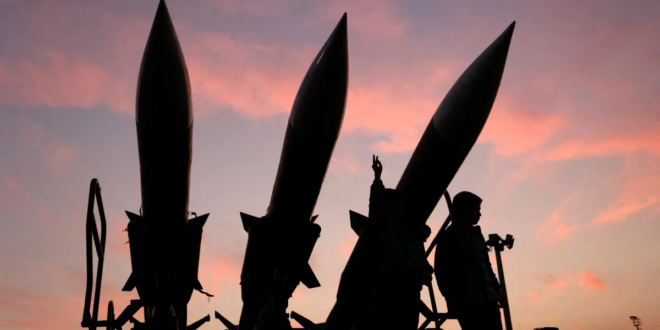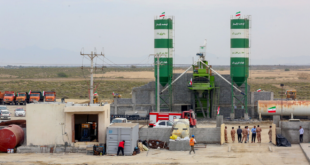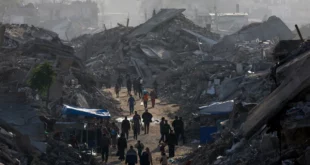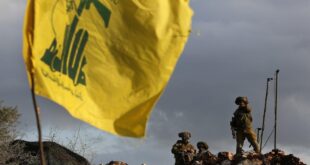How to Turn Maximum Pressure Into Personal Diplomacy
On Saturday, April 12, American and Iranian officials will restart talks over curbing Tehran’s nuclear program. The talks come after U.S. President Donald Trump sent a letter, in early March, to Iranian Supreme Leader Ali Khamenei proposing negotiations. “We have a very big meeting,” the president said in announcing the talks. “We’ll see what can happen.”
There are reasons to hope that Trump’s overtures will succeed. The president has an almost instinctive love of dealmaking, and he has said he wants to make Iran prosperous again. But there are also reasons to be trepidatious. Even as they have embraced talks, Trump’s officials have upped the pressure on Tehran. The administration has doubled down on enforcing sanctions—an approach seemingly aimed at bankrupting Iran—and launched airstrikes on the Iranian-backed Houthis in Yemen. And Trump himself has even given Iran a tight two-month deadline to reach an agreement about its nuclear program. If the two sides fail, he has explicitly threatened to attack the country.
No one should want a war between Iran and the United States. If Washington strikes Tehran’s nuclear facilities, it might set back the program temporarily. But Iran could then double down on its efforts to go nuclear. Iran would also immediately respond with regional attacks of its own, further roiling the Middle East. There is a reason why even Trump has said that “everybody agrees that doing a deal would be preferable to doing the obvious.”
But it is one thing to start negotiations; it is another to reach an agreement. There is no doubt that the United States can inflict significant economic pain on the Islamic Republic by wielding a sharp saber: both were evident during Trump’s first term and with the “maximum pressure” economic sanctions he has revived. Yet to bear diplomatic fruit, Trump must pursue attainable aims rather than expect outright capitulation from Tehran. Iranian officials believe that the only thing more dangerous than suffering from U.S. sanctions is surrendering to maximalist demands.
That does not mean that pressure has no place in diplomacy with Iran. The Islamic Republic is more willing to talk with Trump’s administration than it was with Biden’s because the accumulated impact of sanctions has put the Iranian economy in dire straits and because Iran is more vulnerable than it has been in decades. Eighteen months of war with Israel have left Iran’s network of allies greatly diminished and its own aerial defenses weakened.
But U.S. pressure must be linked to realistic goals. After all, the 2015 nuclear deal came about not simply because of the bite of extra sanctions but also because the United States was prepared to drop its requirement that Tehran shut down its nuclear program entirely, as long as Iran’s stockpiles of uranium and plutonium were sharply restricted and extensively monitored. If Trump really wants to ink an agreement, he must—like Iran—be prepared to be accommodating at least to some degree. He should, for example, be willing to let Iran maintain elements of its nuclear program or missiles program while still offering sanctions relief, including on Iran’s oil trade, and access to frozen assets. Otherwise, talks may fall apart, forcing a regional war that no one wants—and that is almost certainly contrary to U.S. interests.
THE FINAL COUNTDOWN
The 2015 Iran nuclear deal, although complex, was a relatively straightforward bargain. The Islamic Republic accepted restrictions and transparency measures on its nuclear program, and in exchange it received sanctions relief. The agreement did not curtail Iran’s missile program and backing for nonstate actors across the Middle East; Tehran refused to countenance either as part of negotiations. But the resulting deal still imposed serious limits on Iran’s behavior. The country capped its enrichment and stockpiling of uranium, and it opened up its nuclear facilities for rigorous international monitoring.
Then, in 2018, Trump abandoned the deal, and the country’s nuclear development accelerated. Today, Tehran is able to produce the fissile material needed for a nuclear warhead in a matter of days, and it possesses a stockpile that could allow it to make multiple weapons. Most estimates suggest that, if it wanted, Iran could build workable bombs in just a few months. The Islamic Republic, in other words, is on the threshold of becoming the world’s tenth atomic power.
Many Iranian political elites have begun demanding that the country go nuclear. Iran’s regionwide network of allies—the so-called axis of resistance—is weaker today than it has been in years, making it harder for the country to threaten Israel and the United States. For Iran, Israel’s weakening of Hezbollah in Lebanon is a particularly big setback. Tehran saw the group as its principal deterrent against Israel, but then Israel destroyed its stockpile of missiles and killed its top commanders. Hard-liners in Tehran increasingly argue that they need nuclear weapons to keep Iran secure. Khamenei, by contrast, still seems to view the nuclear program as negotiating leverage. He may also fear that Israeli or U.S. intelligence agencies would notice a dash toward weaponization, prompting a strike. But as tensions ratchet up, he is likely to face more pressure from within Iran’s establishment.
Iran is on the threshold of becoming the world’s tenth atomic power.
Time is running out for other ways, too. The 2015 nuclear deal featured a snapback mechanism, designed to allow any of the agreement’s parties to reimpose international sanctions. This provision, however, expires in October, so the time to use it is running out. Without a peaceful solution to roll back Iran’s nuclear advances, France, Germany, and the United Kingdom will likely trigger the snapback. China and Russia might want to block it from taking effect, but their usual UN Security Council veto power would not apply in this circumstance (thanks to an explicit provision of the nuclear deal). Western powers would assert—at least on paper—that the Islamic Republic is once more subject to pre-2015 restrictions.
Iran, for its part, has threatened that it will withdraw from the Nuclear Nonproliferation Treaty if the sanctions return, which would clear the way for Tehran to reduce almost all formal monitoring of its program. Trump, in turn, will face even more pressure from Israeli leaders and hawks in Washington to strike. Israel might even consider attacking alone—which would almost certainly draw in the United States.
Yet even a massive American and Israeli attack would be unlikely to put an end to Iran’s nuclear program. The Islamic Republic simply has too much enriched material and has stored too many advanced centrifuges in too many places for the U.S. and Israeli militaries to destroy it all with absolute certainty. It also has many nuclear experts who can be tasked with reviving a program from the rubble. Even the United States’ own intelligence estimates project that the setback to the program from a military attack would be short-lived—perhaps just a few months. To truly stop a program by using force, the United States would need to either repeat military strikes on a frequent basis or try carrying out a regime change campaign to break that cycle, with devastating and highly uncertain results.
Striking Iran could also cause major regional escalation. Iran’s network of allies might be weak, but the country still has options—particularly through the Houthis or Iranian-backed groups in Iraq—as well as its own ballistic missile stockpiles. It could retaliate against Israel and against U.S. assets, troops, and interests. As a recent American intelligence assessment noted, Iran, although bruised and bloodied from the past year, retains capacity for “inflicting substantial damage to an attacker, executing regional strikes and disrupting shipping.” Iran could even hit the Gulf’s oil infrastructure, driving up oil prices.
GETTING TO YES
These facts are all decidedly grim. But no one would benefit from a U.S.-Iranian war, so everyone has an incentive to avoid it. That gives diplomacy a chance.
The forthcoming talks, to be held in Oman, could set things on a promising track. The parties should try to achieve two aims: clarifying the format of engagement and outlining the broad scope of the endgame. Tehran continues to be noncommittal about whether it will directly interact with U.S. officials, which is both unwieldy and inefficient. The stakes are too high and time is too short for the Iranians to avoid face-to-face engagement with their American counterparts. For its part, the United States should approach the talks mindful that a “Libya model” (as Israeli Prime Minister Benjamin Netanyahu proposed) of demanding the complete dismantling of Iran’s nuclear infrastructure is unlikely to work. Restrictions and transparency, on the other hand, can, and they would go a long way toward addressing nonproliferation concerns, demonstrably moving the Islamic Republic’s program away from the nuclear threshold. Finding clarity and, ideally, enough common ground on these issues could then facilitate more intensive, granular discussions over the finer points.
For talks to work, Tehran and Washington must also recognize the other’s broader diplomatic requirements. Iran will not properly negotiate if Washington holds a gun to its head. Trump will not seriously talk unless he can engage in the kind of direct, personal diplomacy that he desires—namely, in a meeting with Iranian President Masoud Pezeshkian—and which all of his predecessors have been denied. In other words, the two sides need to come to terms with how the other approaches negotiations if they want to find common ground.
One way to increase the momentum of the Oman talks and shield them against efforts at sabotage is for Trump, who is likely to be their chief champion, to directly step in to the diplomatic process. Trump’s first-term record makes it clear that he is no softie when it comes to Iran. If a nuclear deal is to be had, then, Trump may be uniquely positioned to get American hawks to support it, just as former U.S. President Richard Nixon was able to visit China and thaw relations between Beijing and Washington. Trump could advance the process by making a simple but significant quid pro quo that would open the door to direct high-level diplomacy: temporarily suspending maximum pressure sanctions in exchange for Iran suspending its uranium enrichment for the same period of time. That could pave the way for the presidential-level meeting Trump has sought for a long time. If they are serious about advancing talks, Oman, Saudi Arabia, the United Arab Emirates, or another mediator whom Trump respects should propose such an arrangement. They could then host both the high-level meeting and subsequent technical discussions.
Iran and the United States have a bitterly adversarial history. There is a chasm of mistrust between the two countries that diplomacy will struggle to bridge. But an agreement remains possible. Iran needs a deal. Trump wants one. And the alternative to successful negotiations would be catastrophic.
 Eurasia Press & News
Eurasia Press & News




